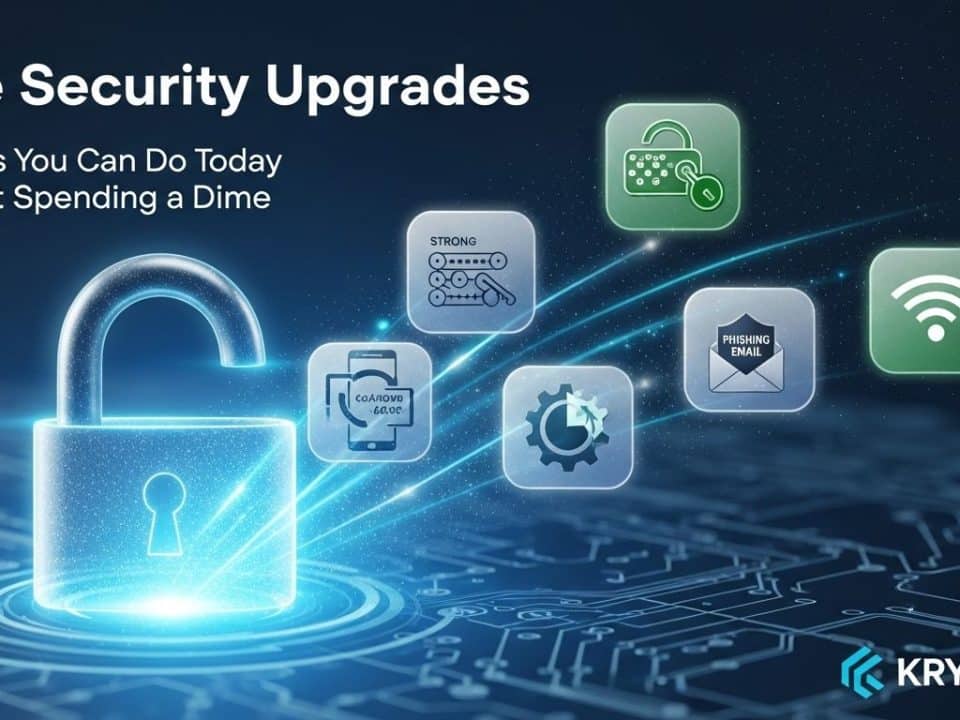
Vetting Your Cloud Provider: A Security Guide for SMBs
November 12, 2025
Free Security Upgrades: 5 Things You Can Do Today Without Spending a Dime
November 13, 2025For decades, small to medium-sized business (SMB) owners operated on a simple security principle: “Trust, but verify.” If a device or employee was inside the network firewall, it was largely trusted. The perimeter was the castle wall, and everything inside was safe.
That model is dead.
In today’s cloud-centric world, where employees work from home, access data from personal phones, and collaborate with countless third-party vendors, that old trust model is a massive liability. The modern standard for security is Zero Trust, a powerful philosophy that dictates one non-negotiable rule: Never trust, always verify.
At Krypto IT, we believe adopting a Zero Trust mindset is the single most important shift an SMB can make today to protect itself from insider threats, compromised credentials, and lateral ransomware attacks.
The Problem with the Old “Castle and Moat” Model
The traditional security model—the “castle and moat”—assumes that once a user is authenticated through the main firewall (the moat), they are free to roam the entire internal network (the castle).
- Vulnerability: This fails the moment a hacker gets a single stolen login credential (from a phishing attack) or when an employee’s laptop gets infected. Once inside the perimeter, the attacker has unrestricted access to sensitive servers and data.
- Zero Trust Solution: Zero Trust treats every login attempt and every data access request as if it originated from outside the network, regardless of the user’s physical location or connection.
What Does Zero Trust Actually Mean for an SMB?
Zero Trust is a philosophy built on three core pillars of verification. It is a proactive framework that ensures breaches are contained and damage is minimized.
1. Verification of Identity (Who is accessing the data?)
Zero Trust never relies on a simple username and password. It recognizes that identities are the new perimeter.
- Mandatory MFA: Every single user, from the CEO to the intern, must use Multi-Factor Authentication (MFA) for every application, every time. If an attacker steals a password, they are stopped cold at the second verification factor.
- Strong Identity Management: Access should be managed through a central Identity and Access Management (IAM) system (like Single Sign-On, or SSO) that monitors every login for anomalies (e.g., Bob usually logs in from Houston, but suddenly there’s a login attempt from Eastern Europe).
2. Verification of Device (What is accessing the data?)
In a Zero Trust world, the device itself must be trusted, not just the user.
- Device Health Check: Before accessing corporate resources, the network checks the device’s security posture. Is the operating system patched and up-to-date? Is the encryption enabled? Is the Endpoint Detection and Response (EDR) software running?
- BYOD Risk Mitigation: If an employee uses a personal (BYOD) laptop or phone, Zero Trust ensures that device meets minimum corporate security standards before granting access, effectively protecting the network from unmanaged personal devices.
3. Least Privilege Access (What can they touch?)
Once the identity is verified and the device is trusted, the final step is authorization. This is the Principle of Least Privilege (PoLP).
- Limiting Scope: A user should only be given access to the specific applications, folders, or data streams that are absolutely essential for their job function—nothing more.
- Damage Containment: If a user account is compromised, the hacker’s “blast radius” is confined to the minimum possible area. The attacker cannot pivot to the financial server, the HR database, or the backup repository. This critical step prevents a compromised user from leading to a company-wide disaster.
Implementing Zero Trust: The Krypto IT Approach
While the concept of Zero Trust sounds enterprise-level, Krypto IT makes it manageable and affordable for SMBs by focusing on immediate, high-impact implementation steps:
- MFA Everywhere: We implement and enforce mandatory MFA across email, cloud apps (Microsoft 365, Google Workspace), and VPN access.
- Network Micro-Segmentation: We use network segmentation to create internal “digital walls,” ensuring that one compromised area (like the guest Wi-Fi) cannot access critical data servers.
- Managed EDR and Patching: We ensure all devices are continuously monitored, correctly patched, and running advanced EDR to verify device trustworthiness in real-time.
- Least Privilege Enforcement: We audit and configure user access to ensure that permissions are strictly role-based and temporary administrator access is logged and managed.
Zero Trust is not about being suspicious of your team; it’s about acknowledging the reality of modern cyber threats. It’s a proactive defense that recognizes that credentials get stolen, people make mistakes, and devices fail. By eliminating implicit trust, you build a resilient business that can contain and recover from any security incident.
Stop relying on a security model that failed years ago.
Ready to Verify Every Access Attempt?
Krypto IT specializes in translating advanced security concepts like Zero Trust into practical, effective, and manageable solutions for Houston SMBs.
Contact us today for a complimentary security assessment and let us help you build a modern, trustless defense perimeter that protects your data and your future.




